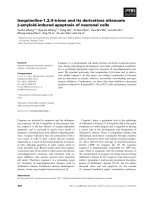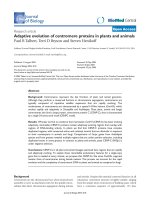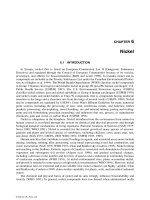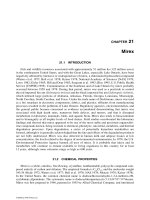3 4 plants and animals living together (life science)
Bạn đang xem bản rút gọn của tài liệu. Xem và tải ngay bản đầy đủ của tài liệu tại đây (4.03 MB, 14 trang )
Life Science
by Jocelyn Vial
Genre
Nonfiction
Comprehension Skill
Draw Conclusions
Text Features
•
•
•
•
Captions
Diagrams
Labels
Glossary
Science Content
Plants and
Animals
Scott Foresman Science 3.4
ISBN 0-328-13817-7
ì<(sk$m)=bdibhd< +^-Ä-U-Ä-U
Vocabulary
What did
you learn?
Plants
and Animals
carnivore
germs
1. Give examples of how animals interact in a
helpful way and a harmful way.
competition
herbivore
consumer
omnivore
2. What do livingby
things
compete
Jocelyn
Vialfor?
decay
predator
decomposer
prey
3. What are two natural events that can change
environments?
disease
producer
Living Together
4.
In this book you have read
about staying healthy. Write to explain three
ways people can stay healthy. Use examples
from the book as you write.
5.
Draw Conclusions If you knew one part
of a food chain was missing, what conclusion
could you make?
germs
Illustration: 19 Jeff Mangiat
Photographs: Every effort has been made to secure permission and provide appropriate credit for
photographic material. The publisher deeply regrets any omission and pledges to correct errors called to its
attention in subsequent editions. Unless otherwise acknowledged, all photographs are the property of Scott
Foresman, a division of Pearson Education. Photo locators denoted as follows: Top (T), Center (C), Bottom
(B), Left (L), Right (R) Background (Bkgd)
Title Page: ©D. Robert and Lorri Franz/Corbis; 2 ©Rick Raymond/Index Stock Imagery; 4 ©Stephen
Frink/Corbis; 5 ©Michael & Patricia Fogden/Corbis; 6 (BL) ©Carol Havens/Corbis, (BR) ©Frank
Blackburn/Corbis; 6 (BR) ©D. Robert and Lorri Frantz/Corbis; 7 (CL) ©K. H. Haenel/Zefa/Masterfile
Corporation, (TR) ©Randy Wells/Corbis, (CR) ©Danny Lehman/Corbis; 8 (CL) ©Frank Blackburn/Corbis,
(B) ©D. Robert and Lorri Franz/Corbis; 9 (CL) Getty Images, (CR) ©Yva Momatiuk/John Eastcott/
Minden Pictures, (BR) ©Naturfoto Honal/Corbis; 10 ©Raymond Gehman/Corbis; 11 (Bkgd) ©Martin
Harvey/Photo Researchers, Inc.; 11 ©DK Images; 12 ©Harry Engels/Photo Researchers, Inc.; 13 (T)
©Bob Daemmrich/Corbis, (CC) Getty Images, (B) ©Ed Bock/Corbis; 14 ©Gary Braasch/Corbis; 15
(CR) ©Bruce Forster/Getty Images, ©Jim Brandenburg/Minden Pictures; 16 (CL) ©G. Biss/Masterfile
Corporation; 17 (Bkgd) Getty Images; 20 Getty Images; 22 (BL) ©DK Images, (CR) ©S. Lowry/University
Ulster/Getty Images
ISBN: 0-328-13817-7
Copyright © Pearson Education, Inc.
All Rights Reserved. Printed in the United States of America. This publication is
protected by Copyright and permission should be obtained from the publisher prior
to any prohibited reproduction, storage in a retrieval system, or transmission in any
form by any means, electronic, mechanical, photocopying, recording, or likewise. For
information regarding permissions, write to: Permissions Department, Scott Foresman,
1900 East Lake Avenue, Glenview, Illinois 60025.
3 4 5 6 7 8 9 10 V010 13 12 11 10 09 08 07 06 05
Think about these examples. Many animals live
How do living things interact?
together in herds. The animals of the herd protect
Ways Living Things Interact
each other. Flowers need light to grow. Sometimes
Living things interact in many ways. An interaction
between them can be helpful. It may help a living
thing survive. Animals living in groups help each
flowers grow on trees. Then they can get more light.
Insects drink nectar from flowers. When they do this,
they spread the flowers’ pollen to other flowers.
other. One kind of living thing may help another. Two
different kinds of living things may help each other.
Members of a
herd protect
each other.
A tree helps
a flower get
light.
An insect
gets nectar.
It spreads the
plant’s pollen.
Honey bees interact in their hive.
2
3
Living in Groups
Some plants and animals live in groups. Members
of the group protect each other from predators.
For example, prairie dogs live in groups. A prairie
One Living Thing Helping Another
Sometimes an interaction helps only one thing.
A barnacle is a small animal. It attaches to the skin
of a whale. As the whale swims, the barnacle opens
dog whistles if it senses danger, such as a predator.
its shell to catch food. The whale helps the barnacle
This tells the whole group of prairie dogs to run and
get food. But the barnacle does not help the whale
hide. They stay hidden until the danger is gone.
in any way.
These fish live in a group. How do you think the fish help each other?
Helping One Another
In some interactions, different kinds of living things
are partners. They help each other.
The yucca moth helps the yucca plant. The moth
moves pollen from one yucca to another.
The plant also helps the moth. It gives the moth a
place to lay its eggs. It also gives the moth food for
its young.
Barnacle
4
Yucca moth and
yucca plant
5
How do living things
get energy?
Do you know which of these
animals is an omnivore? The
bear! A wolf eats only meat.
It’s a carnivore. Sheep are
herbivores. They eat only plants.
Sources of Energy
A living thing that makes its own food is a
producer. All green plants are producers. They make
food by using energy from sunlight. They also use
matter from air and soil.
Some living things cannot make their own food.
They get energy from the food they eat. A living thing
that eats food is a consumer.
Sunlight gives
an ecosystem
all its energy.
Sunlight
This cattail is a
producer. This crayfish
is a consumer. So is
this raccoon
Kinds of Consumers
Raccoon
A consumer that eats only plants is an herbivore.
A consumer that eats only animals is a carnivore.
Some consumers eat both plants and animals. This
type of consumer is an omnivore.
Cattails
6
Crayfish
7
Food Chains
Energy in a Food Web
The cattail, crayfish, and raccoon make up a food
Two or more food chains make a food web. Energy
chain. A food chain is a group of producers and
moves in many different ways in a food web. A Great
consumers that interact. The crayfish eats the cattail.
Plains food web is pictured below.
It gets food energy from the plant. Then the crayfish
becomes prey for the raccoon. Prey is any animal that
others hunt for food. An animal that hunts food is a
A Changing Food Web
When one part of a food web changes, other parts
predator. Energy moves from producers to prey to
change. What would happen if prairie dogs were
predators. Each organism gives off some of this energy
removed from the web? Ferrets would not have enough
as heat.
food. They would start to die out. Animals that eat
A cattail uses energy from
the Sun to make food.
ferrets would have to find other food. This could affect
the mouse population.
The crayfish eats
the cattails.
Cow
Ferret
Badger
Prairie
grasses
Prairie dog
Eagle
The raccoon eats
the crayfish.
8
Mouse
9
How do living things
compete?
Competing for Resources
Other Kinds of Competition
Living things compete for space. Purple loosestrife
is a plant that takes space from other plants in many
places. Some animals compete with humans for space.
Living things also compete for oxygen. Sometimes
When two or more living things need the same
too many algae grow in a pond, lowering oxygen
resource, they are in competition. Living things
levels. Animals must compete for the oxygen left.
compete for food, water, sunlight, and living space.
Predators and Prey
Groups of predators compete for prey. Hunting birds
Competition can follow a cycle. The amount of food
can affect a population of animals. The population,
then, can affect the amount of food. The cycle begins
again.
are one example. Faster, stronger birds may catch
more prey or steal prey from other birds.
Algae
Prey also compete. A strong deer has a better
chance of escaping a predator.
What are these animals
competing for?
Purple
loosestrife
10
11
How do environments
change?
Natural events such as droughts, hurricanes, and
floods, can also change environments. Little rain falls
during a drought. Plants and animals may not get
enough water during droughts. Hurricanes can wash
Causes of Change
away beaches, knock trees over, and cause flooding.
Living things can change their environment. A
beaver builds a dam across a stream. The dam floods
A flood can kill plants, spread mud, move good soils,
and destroy animals’ homes.
many dry places. It forms a wetland. Fish and birds
can live in the wetland. But animals who lived on the
dry land must move. Those animals must find new
How have these
environments changed?
homes. Some may not survive.
Drought
How is this beaver
changing the
environment?
Hurricane
Flood
12
13
Living Things Return
In 1980 the volcano Mt. St. Helens erupted in the
Patterns of Change
Living things change together. Often the changes
state of Washington. The blast knocked down and
happen in patterns. For example, trees grow old,
burned trees. It sent mud and rocks sliding. Few living
die, and fall. Decomposers feed on the dead trees. A
things survived in the area of the eruption.
decomposer is a living thing that breaks down living
Over time, wind carried seeds to Mt. St. Helens. New
things that have died. This is called decay. Decay can
plants grew. Animals returned. Today Mt. St. Helens is
make the soil good for growing new trees. These trees
filled with life. But the mountain could erupt again.
will die someday and decay also. The life cycles of the
Forest fires can destroy habitats in the same way.
two different trees are connected.
Forest fires may also improve habitats for
existing plants and animals.
Mt. St. Helens changed the
environment. But living
things returned.
Decay makes it possible
for new trees to grow.
These mushrooms
cause decay.
14
15
What is a healthy
environment for people?
People need air. The air is often cleaner
outside cities.
People need a clean environment. To keep it clean,
waste must be removed. Garbage and other waste go
What People Need
People need many things to live. They get these
to different places. Some towns and cities put garbage
in a landfill.
things from the environment.
People need food. Most people buy their food.
It comes from farms and ranches.
People need shelter. Shelter protects people from
the weather.
People need clean water. Many people get
their water from special lakes. These lakes are
called reservoirs.
Do you know where your
food and water come from?
16
17
Healthful Foods
From Food to Energy
Eating healthful foods helps people get all the
When you eat food, your digestive system goes to
vitamins, minerals, and other nutrients their
work. It breaks food down. It turns food into a form
bodies need.
your body can use.
Look at the picture below. It shows some of the
Look at the drawing. It shows the main parts of the
foods that your body needs, such as fruit, vegetables,
digestive system. They turn food you eat into energy
dairy food, and fish. You should also eat whole grains,
you need to live and grow!
nuts, eggs, and meat. Food should be fresh, clean, and
stored properly.
Is this the kind of
food you eat?
Food is crushed in your
mouth and then mixed
with digestive juices
in your stomach. Your
small intestine does
most digesting. It also
moves particles into
your blood. The large
intestine removes food
you cannot use.
Mouth
Stomach
Small
intestine
Large
intestine
18
19
Exercise keeps people in shape. People who are in
How can people stay healthy?
shape have more energy. They can work and play.
Exercise
They can feel good about themselves.
Exercise, like healthful foods, builds healthy bodies.
People get exercise in different ways. They may swim
or skate. They may clean the house or rake the yard.
It’s important to try to stay healthy. You can stay
healthy by eating good foods. You can also stay
healthy by getting enough exercise and rest.
Exercise helps keep your heart, lungs, and
muscles strong. These are important parts of
your body’s systems.
20
What is your
favorite kind
of exercise?
21
Avoiding Germs
Have you ever had the flu? The flu is an illness
caused by germs.
Germs are very small living things or particles.
Viruses and bacteria are germs. Many germs can
cause disease. A disease is when your body or part
of your body does not work properly.
Most illnesses are not dangerous. Still, it’s better to
be healthy than to be sick!
Stopping the Spread of Germs
You can do many things to stop
Flu virus
the spread of germs. Just follow these
simple rules. First, stay home from
school when you are ill. Second, wash
your hands often. Third, cover your
nose and mouth when you sneeze or
cough. Fourth, clean and cover all
cuts and scrapes.
Microscope
A microscope can be
used to observe very
small things.
22
23
Glossary
Vocabulary
What did you learn?
carnivore
carnivore
a consumer
germs that eats only animals
competition
competition
when
two or more living things need
herbivore
1. Give examples of how animals interact in a
helpful way and a harmful way.
the same resource
2. What do living things compete for?
consumer
a living thing that eats food
decay
the breakdown of waste and things
3. What are two natural events that can change
environments?
that have died
4.
In this book you have read
about staying healthy. Write to explain three
ways people can stay healthy. Use examples
from the book as you write.
5.
Draw Conclusions If you knew one part
of a food chain was missing, what conclusion
could you make?
consumer
decay
decomposer
disease
omnivore
predator
prey
producer
decomposer
a living thing that breaks down waste
germs
and things that have died
disease
when your body or a part of your
body does not work properly
germs
Illustration: 19 Jeff Mangiat very small living things that can
Photographs: Every effort has been made to secure permission and provide appropriate credit for
photographic material. The publisher deeply regrets any omission and pledges to correct errors called to its
attention in subsequent editions. Unless otherwise acknowledged, all photographs are the property of Scott
Foresman, a division of Pearson Education. Photo locators denoted as follows: Top (T), Center (C), Bottom
(B), Left (L), Right (R) Background (Bkgd)
Title Page: ©D. Robert and Lorri Franz/Corbis; 2 ©Rick Raymond/Index Stock Imagery; 4 ©Stephen
Frink/Corbis; 5 ©Michael & Patricia Fogden/Corbis; 6 (BL) ©Carol Havens/Corbis, (BR) ©Frank
Blackburn/Corbis; 6 (BR) ©D. Robert and Lorri Frantz/Corbis; 7 (CL) ©K. H. Haenel/Zefa/Masterfile
Corporation, (TR) ©Randy Wells/Corbis, (CR) ©Danny Lehman/Corbis; 8 (CL) ©Frank Blackburn/Corbis,
(B) ©D. Robert and Lorri Franz/Corbis; 9 (CL) Getty Images, (CR) ©Yva Momatiuk/John Eastcott/
Minden Pictures, (BR) ©Naturfoto Honal/Corbis; 10 ©Raymond Gehman/Corbis; 11 (Bkgd) ©Martin
Harvey/Photo Researchers, Inc.; 11 ©DK Images; 12 ©Harry Engels/Photo Researchers, Inc.; 13 (T)
©Bob Daemmrich/Corbis, (CC) Getty Images, (B) ©Ed Bock/Corbis; 14 ©Gary Braasch/Corbis; 15
(CR) ©Bruce Forster/Getty Images, ©Jim Brandenburg/Minden Pictures; 16 (CL) ©G. Biss/Masterfile
Corporation; 17 (Bkgd) Getty Images; 20 Getty Images; 22 (BL) ©DK Images, (CR) ©S. Lowry/University
Ulster/Getty Images
make people ill
herbivore
a consumer that eats only plants
omnivore
a consumer that eats both plants and
animals
predator
ISBN: 0-328-13817-7
prey
a consumer that hunts for food
any animal that is hunted by others
Copyright © Pearson Education, Inc.
for food
All Rights Reserved. Printed in the United States of America. This publication is
protected by Copyright and permission should be obtained from the publisher prior
producer
a living thing that makes its own food
to any prohibited reproduction, storage in a retrieval system, or transmission in any
form by any means, electronic, mechanical, photocopying, recording, or likewise. For
information regarding permissions, write to: Permissions Department, Scott Foresman,
1900 East Lake Avenue, Glenview, Illinois 60025.
3 4 5 6 7 8 9 10 V010 13 12 11 10 09 08 07 06 05
24









